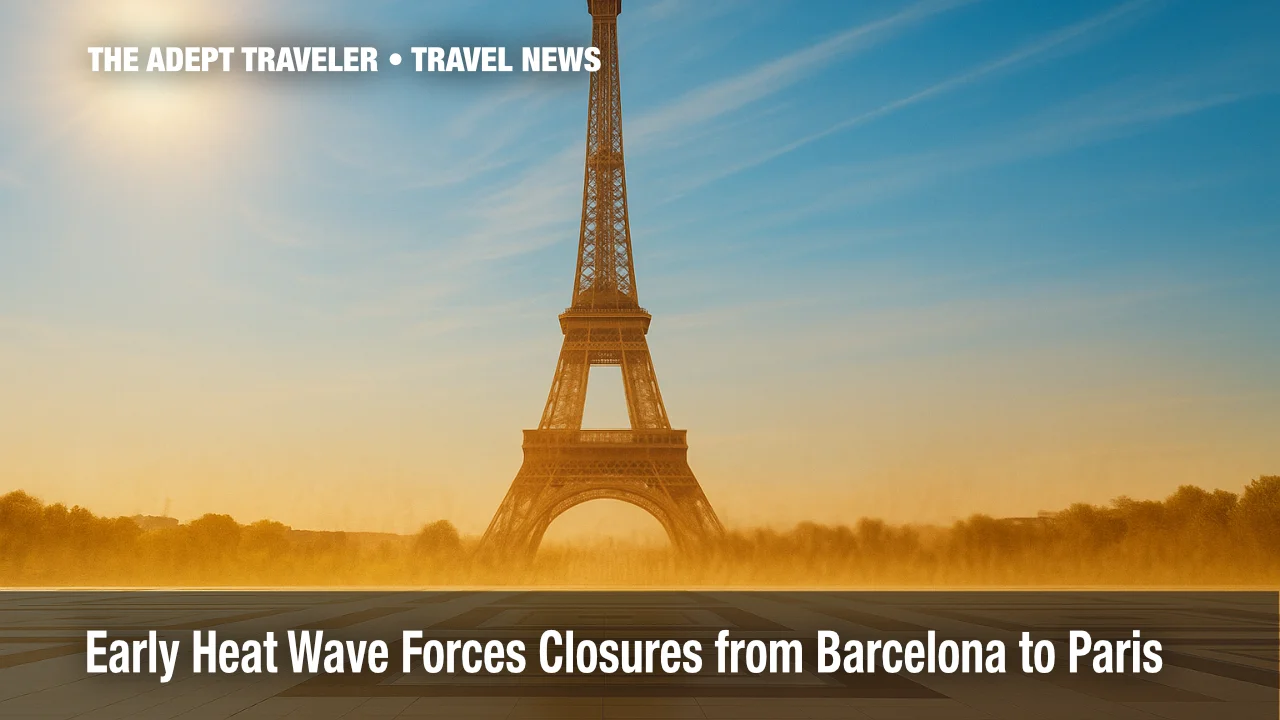Europe Heat Wave Disrupts Summer Travel as Records Break Across the Continent

A formidable Europe heat wave is rewriting June weather records, shuttering marquee attractions such as the Eiffel Tower's summit, and pressuring public services from Barcelona to Brussels. As temperatures soar well past 100 °F in several countries, travelers face schedule changes, health risks, and unexpected costs. Understanding how the extreme heat is unfolding-and how destination authorities are responding-will help you adjust plans on the fly and stay safe.
Key Points
- Barcelona hottest June on record-average 26 °C (78 °F).
- Eiffel Tower summit closed; other sites restrict hours.
- Why it matters: Heat warnings now affect tourism hubs in at least nine countries.
- 1,900 + French schools shut; Italy bans some outdoor work.
- Spain and Portugal each set new national June temperature highs at 46 °C +.
Europe Heat Wave Snapshot - How It Works
A stagnant high-pressure "heat dome" has parked over western and central Europe, compressing hot Saharan air and blocking cooler Atlantic fronts. Cities lack overnight relief, with lows staying above 80 °F-amplified by urban "heat islands." National meteorological agencies activate tiered alert systems: green (routine) to red (extreme). Red alerts empower local governments to close schools, limit large events, and open "cooling refuges" in museums, churches, and air-conditioned transit stations. For visitors, these measures can upend sight-seeing schedules, ticketed events, and rail timetables with little notice.
Europe Heat Wave Background - Why It Matters
Southern Europe has battled lethal summer heat since 2003, but the frequency, early arrival, and geographic spread are accelerating. Copernicus Climate Change Service notes the continent is warming about twice as fast as the global average. Past heat waves have slowed rail networks, grounded aircraft, and driven excess deaths exceeding 60,000 in 2022. This year's episode arrives on the heels of the hottest global summer on record, underscoring the trend toward more frequent climate-driven disruptions that can catch under-prepared travelers off guard.
Europe Heat Wave Latest Developments
A sweltering spell that began over Iberia in late June crept northward on July 1, 2025.
Records Fall and Alerts Rise
- Barcelona hottest June: The Fabra Observatory averaged 26 °C-its warmest since record-keeping began in 1914. A same-month single-day high hit 37.9 °C (100 °F).
- In Spain's Huelva province, El Granado logged 46 °C (114.8 °F), the nation's highest June mark.
- Portugal's Mora reached 46.6 °C (115.9 °F), a national June record per IPMA.
- France escalated 16 departments, including all of Paris, to red alert. The step closed more than 1,300 schools, curtailed outdoor events, and kept the Eiffel Tower summit closure in place for a second day.
- Belgium, the Netherlands, and western Germany issued their highest June heat advisories in decades; Rotterdam and Cologne both forecast 38-40 °C highs.
Transport, Work, and Health Impacts
- SNCF slowed TGV trains on heat-sensitive tracks and warned of Alpine mudslide detours on the Paris-Milan route.
- Italy activated red alerts in 17 cities, restricting heavy construction between noon and 5 p.m. A construction worker near Bologna died Monday in 104 °F heat.
- Turkey evacuated roughly 50,000 people as wildfires flared near İzmir and Manisa, complicating summer cruise itineraries in the Aegean.
- Mediterranean Sea surface temperatures hit 30 °C (86 °F) off Spain-six degrees above seasonal norms-raising humidity and fueling overnight "tropical nights" that strain power grids.
What's Next
Forecasters expect peak heat to persist through July 3 before cooler Atlantic air reaches France and the western Pyrenees. Yet models show the dome sliding east, threatening Budapest, Vienna, and Prague later this week. Copernicus warns parts of inland France could see 40 °C days as "new normal" summers by 2100, with rare spikes toward 50 °C.
Analysis
For travelers, the Eiffel Tower summit closure is the headline, but the subtler effects can be costlier. Hotel HVAC failures, rail slow-downs, and sudden attraction hour changes translate into extra nights, rebooking fees, or missed bucket-list moments. Budget air carriers already cap cabin temperatures at 35 °C (95 °F); high ramp temps can ground planes midday, so build slack into departure windows. Museums and underground metros offer reliable cooling, but lines lengthen quickly-book timed tickets online and carry at least 1.5 L of water per person. Portable electrolyte packets weigh almost nothing yet fend off heat exhaustion. Trip-insurance clauses often cover "adverse weather" delays; confirm yours before your next move. For broader safety guidance, see our internal Adept Traveler Travel Safety Guide.
Final Thoughts
Extreme heat looks set to dominate European summers. If you plan a city break during a Europe heat wave, monitor local alerts daily, pivot to early-morning touring, and reserve shaded or indoor dining. Should the thermometer top 104 °F, prioritize hydration, rest in climate refuges, and re-evaluate strenuous excursions. By anticipating disruptions and adapting on the fly, you can still capture the magic of midsummer Europe-just at a slightly slower, safer pace.
Sources
- Barcelona records hottest June and Eiffel Tower summit closes as Europe sizzles
- France shuts schools, Italy limits outdoor work in exceptional European heatwave
- Vigilance Canicule Bulletin - Météo-France, 1 July 2025
- Daily Extremes Table - Instituto Português do Mar e da Atmosfera, 29 June 2025
- Europe on High Alert as Surprise Early Heat Wave Creeps North (AFP via Phys.org)
